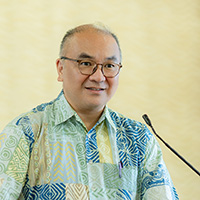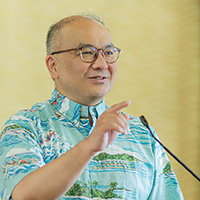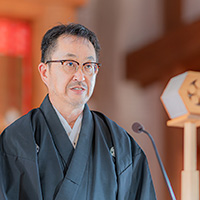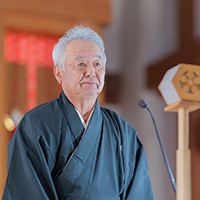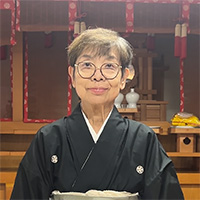
(Summary)
My name is Wakie Onishi and I am from the California Church, located in Los Angeles, and am serving as the head of the Women’s Association California Chapter.
I have kidney disease and in September 1995, I underwent a kidney transplant surgery. Generally, a transplanted kidney is useful for about 10 to 15 years, but this year marks 30 years that I have been blessed with this kidney.
When I feel well, I try to be of service through my work with the Women’s Association and also through missionary work. I have been shown many joys by God.
While I perform my duties in America, one year, at the Women’s Association first meeting of the year, we received the slogan, “Let us willingly administer the Sazuke to those that are ill.”
I was astonished—How should I put it into words, I felt a passionate feeling rising from the depths of my heart. I felt such gratitude and made a spiritual resolution to spend one year administering the Sazuke as much as I can.
From then on, I always kept in mind to administer the Sazuke, prayed during the morning and evening services, and went out to do missionary work. As I prayed every day, interestingly, I was given so many opportunities to administer the Sazuke.
There was a person who I was encouraging to attend the Spiritual Development Course at the Mission Headquarters. When my husband and I visited them, we were informed of his next door neighbor who was sick. He had to have the big toe on his left foot amputated due to diabetes. He was going to be admitted to the hospital the next day, so we hurriedly administered the Sazuke on him.
He was a Hispanic person in his 70s. When he had bypass surgery on his heart previously, he had vascular transplant surgery on his left leg. He had a large scar that stretched from his thigh down to his calf. Due to the diabetes, his leg had become discolored and swollen. He was of Christian faith, but my husband told him, “When I administer the Sazuke, please chant ‘God the Parent’ in your heart,” and then proceeded to administer the Sazuke. And for about five months, when we were able to, my husband and I together, or one of us, would visit him every day.
Next is the story of a 45-year-old Caucasian man. While I was walking alone through a neighborhood distributing pamphlets, I saw a man in a wheelchair watering his garden. Gathering my courage, I approached him and spoke about the Sazuke. He said, “I live here with my mother, and she is inside of the house right now. If you would, please come inside to administer it.”
I showed him the pamphlet and explained the Truth of the Sazuke, and we agreed that I would visit him for three days. Each time I went, he would offer 3 or 5 dollars as a “small donation” to God the Parent. After the three days were over, I visited him together with my husband, the church head minister, and he shared many stories about his life with us.
Four months after he graduated from high school, the man was held up by a robber in Hollywood, ordered to lay on the ground and was shot in the back with a pistol. Fortunately, his life was spared due to the bullet missing his heart by just a little, but it hit the 8th vertebra, severing his nerve, and paralyzing the lower half of his body. He did not have too much strength in his right hand, but he operated his wheelchair with his left hand and he could drive and cook as well.
However, due to the shock from his friend passing away suddenly, his health deteriorated and he started to experience pain all over his body. He tried various painkillers, strong alcohol, and marijuana, trying to escape from his physical and mental pain. Now, he is making an effort to control his pain without using medication as much as possible.
He was out watering the lawn, something he never does, to distract himself from the pain when I happened to talk to him.
I thought, “Wow, what God does is amazing,” and I continued to visit him for a month. When his condition improved, he gave me a $100 check for donation to express his gratitude.
In America, donations in the amount of 3 or 5 dollars are common, ten dollars being a lot, so we were very surprised by this $100 donation.
A person who received the blessings through the administration of the Sazuke may not start following the path right away, but after the accumulation of such diligent work, I have been shown blessings in different forms. For example, when another person with whom I had been communicating over a long period of time suddenly returned to Jiba and listened to the Besseki lectures. Such things lead me to conviction.
My kidney function started to deteriorate after I got contracted with Covid-19 three years ago. At the end of last year, while I was going through such circumstances, I was appointed by the grand church head minister to deliver a sermon after the grand church monthly service. Further, I was told to come back and serve in Jiba after the new head minister installation, and things are on track accordingly.
On July 26th, my eldest son, Taichi, received the divine sanction to become the 5th head minister of the California Church, and my husband became the former head minister. Although I planned to return to Jiba in full of joy for my son’s divine sanction bestowal and Head Minister Qualification Course, I was not confident about my health condition and therefore, I could not go. I was also nervous about staying at my church by myself. The reason for this was that I was fully aware that my health was clearly deteriorating.
When I consulted with grand church head minister, he instructed and said to me, “Whatever happens is an intention of God the Parent and Oyasama. Things to coincide, as a sign for a sign, are also blessings.” Also, he suggested me about the Spiritual Development Course.
The new and former head ministers came back from Jiba at the end of July and we were busy with final stage of the preparation for the installation service which will be held on August 31.
Four days prior to the installation service, my health condition worsened suddenly, and I was hospitalized. Although I was discharged the day before the installation service and I tried to attend the service until the very last moment, I could not feel well enough and ended up not being able to attend the service.
With sincerity of so many people, the installation service was performed successfully, but I had a mixed feeling—I felt bad, disappointed with myself, but I felt grateful at the same time. However, even during such challenging times, I was shown many things that I could be grateful for.
Everyday, after the morning and evening services, the new head minister administers the Sazuke and instructs me to express my gratitude to God for things I am grateful for. I feel that it is very important to take a moment and ponder over how grateful I am now and to express my gratitude.
I do not know what kind of a path I will see in the future, but I would like to lean on God the Parent completely and serve my duty in Jiba.
Whenever you return, never think that it is caused by your individual minds. XI:78
I am sorry for talking about personal stories, but I would like to conclude my sermon now.
Thank you very much for your kind attention.
(Edited by Honjima Tsushin Editorial Staff)
